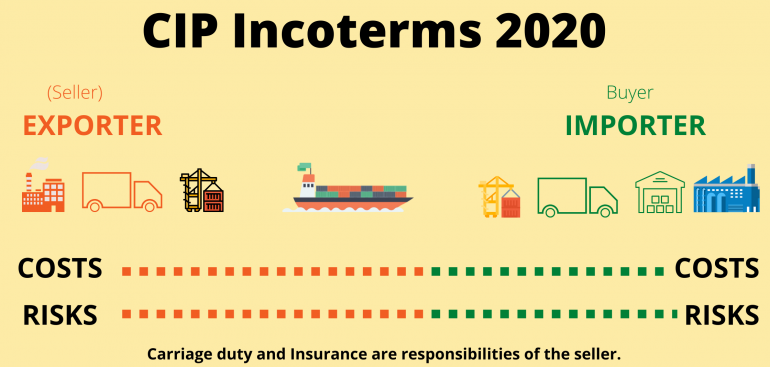CIP incoterm 2020 can be described as Carriage & Insurance Paid To. The only difference is that the CIP seller arranges insurance.
CPT is covered in a separate article. Click here for more information.
As per CIP Incoterm 2020, the seller will deliver the goods to the designated place and insure them. All responsibilities are transferred from the seller to the buyer. The CIP seller arranges both freight and insurance. CIP can be used for any transport mode (surface transportation, air freight, ocean freight, or rail). The seller prepares and packs the goods. Once the goods are loaded, the seller arranges primary transportation. Customs clearance is done. Insurance is taken. The buyer receives the goods.
In CIP, the seller bears all risk until the goods are transferred to the first carrier at a designated place. After that, it is the buyer’s responsibility.
Cost:
The seller must pay for packing, loading, and transportation. The buyer must pay for import customs clearance, duties, and taxes, and unloading at the destination.
Insurance:
In CIP Incoterm 2020 delivery terms, sellers must pay for insurance.
Let us understand CIP delivery terminology through the use of an example.
Let’s say a producer of ceramic tiles from Pune, Maharashtra, India is in contact with a buyer from Melbourne, Australia to trade ceramic tiles. The buyer in Melbourne is looking for the final goods to be delivered to Melbourne port since he’s not well-versed in working at the former works and the documentation in India. They decided to go with CIP incoterms. The seller provides samples so that the buyer can assess what the item is made of.
Negotiation under CIP Incoterm 2020:
They then discuss and decide on the product. They finalise the CIP cost per square foot after several rounds of negotiation and then decide to sign the deal.
Negotiation under CIP Incoterm 2020:
Since the seller and buyer are trading with one another for the first time, the seller chooses to sign an LC (Letter of Credit). The buyer is not opposed to the LC. The contract is signed with a CIP delivery term, which refers to the CIP Melbourne port, and an operational LC, created at the buyer’s bank.
Operations process under CIP Incoterm 2020:
Following the receipt of operable LC, the seller will begin the manufacturing process at their Pune plant. They then communicate the date of loading to the buyers. Meanwhile, the seller approaches the freight forwarder for container booking. The product is shipped from Mumbai port, which is the closest port to the seller because the delivery time is CIP. Melbourne container ports are reserved until Melbourne port.
Port for loading: Mumbai, India
Point of discharge: Melbourne, Australia
After the goods have been manufactured, they will be packed by the seller. Sellers will contact an inspection agency to arrange for a pre-shipment inspection. The agency will then send its representatives to the factory of seller for inspection. After that, the inspection agency will issue an inspection certificate. In the event of a COC, the buyer can nominate an inspector agency and send a COC demand. An inspection will take place, and then COC will be issued to the buyer.
Now the seller must contact their carrier and ship the merchandise to CFS. The containers will then be collected from the CFC empty yard for containers. The goods will be placed in containers before being handed over to customs officers to clear. A customs officer will examine the containers and provide an “approval let export order” once all is found to be satisfactory. Following custom clearance, containers are sent to the port, where they are handed over to the shipper. At this point, the seller’s liability will end and the responsibility of the buyer will take over.
The seller will approach different offices to obtain post-sale documents. After the documents have been arranged, the seller will then submit the documents to their bank in accordance with LC.
Documents:
- commercial invoice
- A Checklist for Packing
- A Bill of Lading
- Certificate of Origin
- Pre inspection certificate
- Certificate of insurance
- Other documents, if any,
The bank of the buyer will notify the buyer after documents have been received. The buyer should contact the bank and sign release papers in accordance with LC conditions.
After the vessel has arrived at the port of discharge, which would be Melbourne in this instance, they will choose an agent to clear customs. They will release the cargo following customs clearance’s completion and then transport the cargo back to their premises.
All this is about CIP incoterm and we hope the above article would have helped you to understand what is CIP shipping and the operation mode. If you have any consultations required for air freight, ocean freight, customs clearance, and Logistics transportation then we have a very committed team of professionals to help you out. You can get in touch with us at Consolidation Shipping Line any time of the day or drop an email at inquiry@cslindia.net

